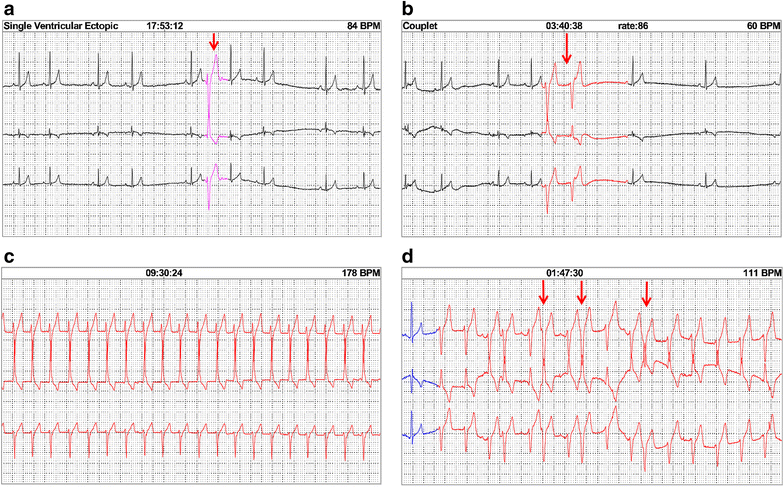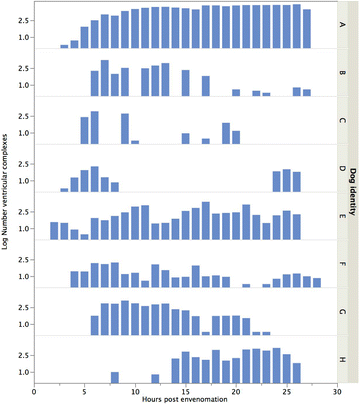Twenty-four-hour ambulatory electrocardiography characterization of heart rhythm in Vipera berus-envenomed dogs
- PMID: 28468664
- PMCID: PMC5415709
- DOI: 10.1186/s13028-017-0296-x
Twenty-four-hour ambulatory electrocardiography characterization of heart rhythm in Vipera berus-envenomed dogs
Abstract
Background: Vipera berus has a worldwide distribution and causes high morbidity in dogs annually. A complication to envenomation may be cardiac arrhythmias. The purpose of this study was to investigate the prevalence, types, and timing of arrhythmias, using 24-h ambulatory electrocardiography (24-AECG), in dogs bitten by V. berus in the first 24-32 h after envenomation. In addition, this study aimed to investigate if there were differences in selected clinical and hematological- and biochemical variables (including cardiac troponin I) at admission between V. berus-envenomed dogs with and without detected pathologic arrhythmias. Seventeen prospectively recruited client-owned dogs acutely envenomed by V. berus, were therefore examined clinically and echocardiographically, sampled for blood, hospitalized, and monitored by 24-AECG.
Results: Clinically significant pathologic arrhythmias in this study were of ventricular origin, such as frequent single ventricular premature contractions (VPCs) and couplets of VPCs, episodes of ventricular tachycardia and idioventricular rhythm, and "R-on-T phenomenon". Variations of these arrhythmias were detected by 24-AECG in eight (47%) of included dogs. No arrhythmias were detected by cardiac auscultation. Twenty-four hours following envenomation, four out of eight dogs experienced decreases (all P < 0.039), and three out of eight dogs experienced increases (all P < 0.034), in arrhythmic episodes. All four dogs bitten on a limb developed pathologic arrhythmias. Otherwise, no significant differences in clinical, hematological or biochemical variables were seen between dogs with pathologic arrhythmias and those without.
Conclusion: Forty-seven percent of dogs bitten by V. berus included in this study experienced pathologic arrhythmias of abnormal ventricular depolarization. During the first 24-32 h from the snakebite, some dogs experienced a decrease in arrhythmic episodes and others an increase in arrhythmic episodes. These findings indicate a potential value of repeated or prolonged electrocardiography monitoring of envenomed dogs for identification of which dogs that might benefit the most from prolonged hospitalization for optimal monitoring and treatment of cardiac abnormalities. In the present study, dogs that developed arrhythmias could not be differentiated from dogs that did not based on clinical findings or hematological or biochemical variables obtained at admission.
Keywords: Ambulatory ECG; Arrhythmia; Dog; ECG; Snakebite; Vipera berus.
Figures


Similar articles
-
Ambulatory electrocardiography and serum cardiac troponin I measurement in 21 dogs envenomated by the European adder (Vipera berus).J Vet Intern Med. 2020 Jul;34(4):1369-1378. doi: 10.1111/jvim.15817. Epub 2020 Jun 18. J Vet Intern Med. 2020. PMID: 32557821 Free PMC article.
-
Cardiac arrhythmias and serum cardiac troponins in Vipera palaestinae envenomation in dogs.J Vet Intern Med. 2008 Jan-Feb;22(1):106-13. doi: 10.1111/j.1939-1676.2007.0026.x. J Vet Intern Med. 2008. PMID: 18289296
-
Myocardial cell damage in 24 dogs bitten by the common European viper (Vipera berus).Vet Rec. 2010 May 29;166(22):687-90. doi: 10.1136/vr.b4817. Vet Rec. 2010. PMID: 20511652
-
[An overview on envenomings inflicted by the Common adder (Vipera berus) and their treatment in Hungary. Facts and beliefs -- part I].Orv Hetil. 2012 Jul 15;153(28):1092-105. doi: 10.1556/OH.2012.29407. Orv Hetil. 2012. PMID: 22776522 Review. Hungarian.
-
Mechanism of Vipera berus venom activity and the principles of antivenom administration in treatment.Przegl Epidemiol. 2013;67(4):641-6, 729-33. Przegl Epidemiol. 2013. PMID: 24741911 Review. English, Polish.
Cited by
-
Ambulatory electrocardiography and serum cardiac troponin I measurement in 21 dogs envenomated by the European adder (Vipera berus).J Vet Intern Med. 2020 Jul;34(4):1369-1378. doi: 10.1111/jvim.15817. Epub 2020 Jun 18. J Vet Intern Med. 2020. PMID: 32557821 Free PMC article.
References
-
- McDiarmid R, Campbell J, Toure T. Snake species of the world: a taxonomic and geographic reference. 1. Washington: Herpetologist’s League; 1999.
-
- Turkovic V, Teichmann S, Dorfelt R. European adder bites in dogs in southern Germany. A retrospective study over a 6.5-year period. Tierarztl Prax K H. 2015;43:221–230. - PubMed
MeSH terms
Substances
LinkOut - more resources
Full Text Sources
Other Literature Sources
Medical
Research Materials

